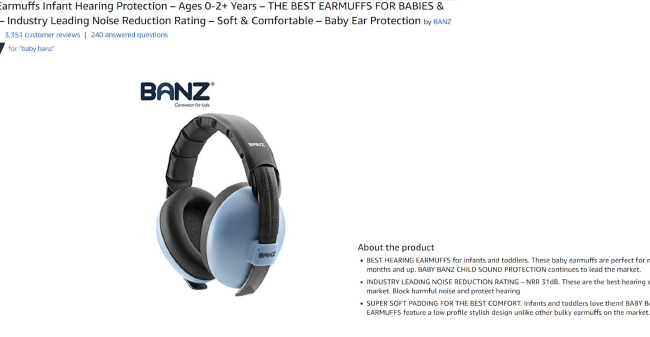How to Succeed in a Competitive Niche

The Baby category is one of the quickest growing on Amazon, and it’s no surprise.
As anyone with kids will tell you, new parents are busy!
These shoppers especially crave competitive pricing and convenience, which is why they turn to Amazon. Plus, as America’s largest generation and Amazon’s core demographic—millennials—transition to parenthood, this niche will continue to grow.
For brands looking to foster loyalty along this new frontier, there are plenty of opportunities for visibility and customer education (and, of course, profitability) on Amazon!
Shoppers in this category are more likely to buy in bulk and opt in to Amazon’s subscribe and save programs. Over one-third of dollars spent in this category are spent online. What’s even better is that Amazon has a solid 50% of the market share, beating out Walmart and Target.
Factors That Influence Sales and Ad Performance in the Baby Category
To say that there are a lot of factors to consider in your Amazon advertising strategy would be an understatement. There are hundreds of tiny decisions to be made constantly when you’re launching a new product or campaign.
But, zoom out for a minute.
Before we get into the fine-tuning, let’s take a look at the big picture by breaking down this category’s conversion rates.
| No. of Transactions | Avg. Price | Conversion Rate | |
| amazon.com | 12,477,000 | 25.46 | 21 |
| amazon.co.uk | 26,961 | 25.77 | 14.4 |
| amazon.de | 7,185 | 21.32 | 16.4 |
| amazon.fr | 6,168 | 24.04 | 12.6 |
| amazon.es | 1,260 | 23.36 | 4.2 |
When you’re focusing on overall conversion rates in a category, you’ll want to look at two main factors: 1.) Product Variations and 2.) Price Point.
1. Product Variations:
From size and color of baby clothes to types of diapers and toys, the number of product variations in the Baby category will be high. This is something you’ll want to keep in mind because the longer a shopper takes to weigh their options, the less likely that they’ll make a purchase.
2. Price Point:
The average price in the Baby category in the U.S. marketplace is $25. Typically, higher product prices require a higher level of commitment, which slows down the buyer’s time to make a final decision. So, if you have a higher priced item, you’ll get a larger return on ad spend, BUT you’ll need to spend more of that return figuring out what converts.
This is a broad look at the category and the general obstacles to conversion. Now let’s look at some specific factors that will play a role in your sales and your advertising strategy.
Summer Strollers and Christmas Toys: Understanding Seasonality in the Baby Category
When you’re building your PPC strategy, you have to take the potential impact of seasonality into account. You’ll want to avoid increasing your ad spend on products that just won’t convert at certain times of the year.
As a seller in this category, let’s say you sell strollers. You’ll likely see a dramatic spike in sales around mid- to late-April which fall hard after the summer when people start to retreat back indoors for the winter. Then, in the winter, toddler toys and popular gift items will spike as shoppers get ready for the holiday season.
On the other hand, if you sell diapers, you’ll see steady demand year-round.
See the difference?
Overall, you’ll want to note which of your products will be affected by seasonality. This insight will be crucial to not only your inventory but also your advertising strategy.
Winning Market Share in the Baby Category
In the Baby category, you may end up facing some large and powerful competitors, not just from other third-party sellers but from Amazon itself as well.
People are much more likely to buy from a brand they recognize and trust when it comes to their baby’s health, safety, and happiness.
The good news for smaller brands that are trying to compete is that although these brands take up primary positions on market share, there are ways to make your product more appealing and steal away customers from these giants. For example, high ratings and number of reviews can communicate trust in your product, which could help you pull ahead.
For brick and mortar competitors, there’s a good chance that staple items, like baby wipes, are cheaper on Amazon than at your local store. When you take that into account (not to mention the time it takes to physically drive to the store and find what you’re looking for), many people prefer to shop from behind their computer screens.
And finally, when it comes to competition from from Amazon itself, the company has two ways of entering a product space on its platform:
- Amazon-sourced/produced brands, one example being AmazonBasics
- Amazon-acquired brands, like home security company Blink
Amazon-sourced/produced brands tend to be somewhat generic, which presents an opportunity to smart sellers. It’s possible to make a play for market share and go up against Amazon as a third-party seller.
To grab victory directly from the e-commerce giant, you need to beat Amazon in quality.
Even with the Amazon name behind it, a product is only as good as the value it provides to its customers. Providing a great product and getting the social proof (in the form of reviews and ratings) to back it up can actually help you to come out on top.
Optimize Your PPC Campaigns to Build Sales Velocity
Now that we have a solid overview of the circumstances you’ll need to consider as a seller in the Baby category, let’s zero in on advertising strategy.
Now, in general, I recommend that 15-20% of your sales should come from paid advertising. This, however, is just a rule of thumb.
If, for example, you’re promoting a new or relatively unknown product, it won’t have had enough time to perform well in organic rankings. In that case, it’s more likely that about 70-80% of those sales will come from paid.
Sales on very mature products, on the other hand, will come more from the organic side, partly because you’ll be able to transfer some of the learnings from your paid strategy into boosting your organic ranking. Plus, Amazon’s algorithm favors products with high conversions, so you’ll organically climb in rank once you start making sales.
Best Practices for Your Keyword Strategy
As you probably already know, the right keywords can make or break a campaign.
When it comes to keyword strategy, there are always a few category-specific considerations that you’ll want to keep in the back of your mind. First, let’s take a look at the terms that currently rank near the top in this category:
- Electric Blanket
- Baby Wipes
- Baby Toys
- Baby Gate
- Baby Monitor
- Paw Patrol Toys
- Heated Blanket
- Weighted Blanket
- Pomsies
- Baby Girl Clothes
Like products, keywords may go through spikes and drops throughout the year. “Electric Blanket” and “Heated Blanket” (#1 & #7), for example, will have a spike in popularity starting in the colder months. However, I think it’s safe to say that “Baby Wipes” is a fairly stable search term all year round.
For these more generic keywords, it’s important to clearly define your value proposition if you want to stand out from the crowd. Because this category sees a very long list of small competitors around the more generic keywords, it will be crucial to optimize your digital shelf so that repeat customers can find and choose your brand in the future.
Tips for Fine-Tuning Your Listings
A great listing helps the shopper to overcome any objections by providing clear, relevant information in an attractive format. It understands the problem that your potential customer is trying to solve and gives them the information they need to make a quick decision.
So what does that actually look like? Let’s see an example:

Why It Works:
- The title is SEO-focused while still attracting readers.
-
- The title includes high volume, relevant keywords (“Earmuffs,” “Hearing Protection”).
- It includes examples of features (“Soft & Comfortable”).
- It uses punctuation to break up the title for readability, which helps to attract even more customers.
- One potential improvement I may suggest would be to add some application keywords to the title (e.g. “Protection for Concerts & Fireworks”).
- The images used in this listing are well-varied and clearly demonstrate key benefits.
-
- It uses a high number of images (6 out the maximum 7).
- There are lifestyle images included to show the product in use.
- There are infographics that clearly illustrate benefits and features.
- While this is overall a good listing, there is one prominent area for improvement. While most of the graphics are appealing, the lifestyle images lack a premium, professional aesthetic, which may turn off buyers looking for a high-quality, trusted product for their child.
- The list of features is well-structured and establishes product superiority over competitors.
- The listing addresses common concerns (“Same Features as Full Sized”).
- Each point begins with a product benefit in full capitalization before specifications.
- This is a great way to draw attention to your benefits!
- This listing focuses on benefits before specifications, which helps to overcome customer objections.
To understand a potential customer’s buying triggers, you’ll need to learn what problem they’re trying to solve and what information they need to learn.
Then, once you know the buying triggers behind your audience, that knowledge will allow you to make intelligent corrections along the way, ultimately leading to a well optimized, high-converting listing.
Final Thoughts
I hope this has helped you to identify the potential pitfalls—along with the amazing opportunities—for sellers hoping to gain market share in this category.
As always, our goal is to help people become category Kings and Queens and dominate their niche—whatever that niche may be. With that being said, if you want to make some major moves, we can help. Apply below.
How Canopy Management Can Help
Canopy Management is a “full service” marketing agency for Walmart and Amazon sellers, and our team consists of former Amazonians, multi-million dollar sellers, and award-winning experts. When you consider the ways in which CANOPY Management is able to help you grow your Amazon business, you’ll know why.
- Strategic Growth Planning
- Listing Copywriting Optimization
- Listing Photography
- Product Videography
- Advertising Management
- Customer Service
- Demand Side Platform (Amazon DSP)
- Amazon Posts
- Full Service Management
- Amazon Review Aggregation



